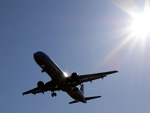Only way is up for aviation
 In a bad week for aviation, the International Air Transport Association has piled on further pressure by publishing its figures for February which show a 22 percent slump in freight and 10 percent fall in passenger volumes, compared to the same period last year.
In a bad week for aviation, the International Air Transport Association has piled on further pressure by publishing its figures for February which show a 22 percent slump in freight and 10 percent fall in passenger volumes, compared to the same period last year.
However the global aviation body did offer a glimmer of hope by predicting that the recent run of declines may have hit the bottom.The 5.9% reduction in passenger capacity volumes, the most aggressive since the crisis began, could not keep pace with the fall in demand, pushing the February load factor down to 69.9% (3.2 percent below the same month in 2008).
International freight volumes fell for the third consecutive month at more than 20% below previous year levels (-23.2 percent in January and -22.6% percent in December).
“Gloom continues. The sharp drop in February passenger traffic shows the broadening scope of the crisis. Freight traffic, which began its decline in June 2008 before passenger markets were hit, has now had three consecutive months in the -22 percent to -23 percent range,” said Giovanni Bisignani, IATA’s Director General and CEO.
“We may have found a bottom to the freight decline, but the magnitude of the drop means that it will take time to recover,” he added.
ADVERTISEMENT
The decline in demand for international travel outpaced capacity adjustments in all regions.
African carriers saw the largest demand decline (-13.7%), outpacing even the most aggressive capacity cuts (-11.8%). Asia-Pacific carriers saw passenger traffic decline by 12.8%, far outstripping the -7.8% capacity adjustment. North American carriers recorded a 12.0% drop in demand, also outpacing an aggressive -7.1% capacity adjustment.
Europe’s carriers saw traffic fall in line with the global average at -10.1%. Long-haul markets to the US and Asia have been particularly hard hit reflecting negative economic sentiment.
Latin American carriers most closely matched demand drops (-3.8%) with capacity adjustment (-2.4%).
Middle East carriers bucked the trend of falling demand with an increase of 0.4% in international passenger traffic. But an aggressive capacity increase of 7.3% drove load factors down 4.7 percentage points to 68.1%.
All cargo markets saw extremely weak demand continue as a result of the collapse in international trade in goods and the much lower shipment of components by manufacturers. However, the level of air freight appears to have found a floor over the past three months.
Bisignani reminded governments that air transport is a catalyst for economic activity and called for policy changes to help them to stimulate economies by playing this role effectively. “Governments are spending trillions to bailout the banks and trillions more to stimulate economies. By comparison, our requests to governments are cost-effective and cheap.”
“First, air transport needs a tax structure that will help preserve industry jobs and allow air transport to play its role as a catalyst for broad economic activity. More broadly governments must replace the mindset of taxing aviation as a luxury or a sin with a strategic approach that recognizes and fosters the industry’s critical economic role in connecting people to business and products to markets. Second, airlines need the commercial freedoms to be able to merge or consolidate where it makes business sense—even across national borders,” said Bisignani.
——-

